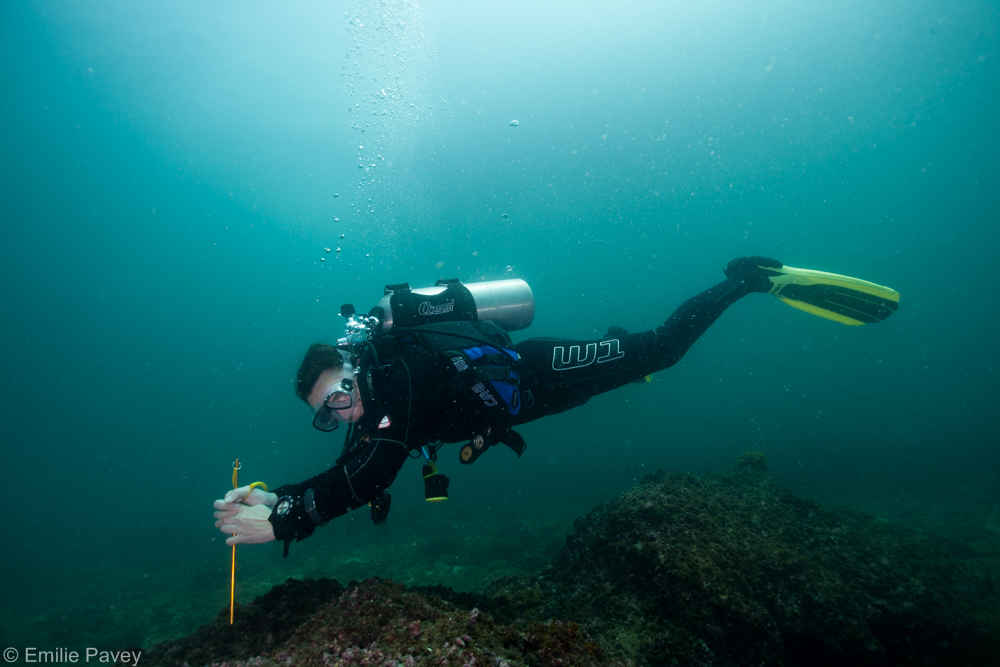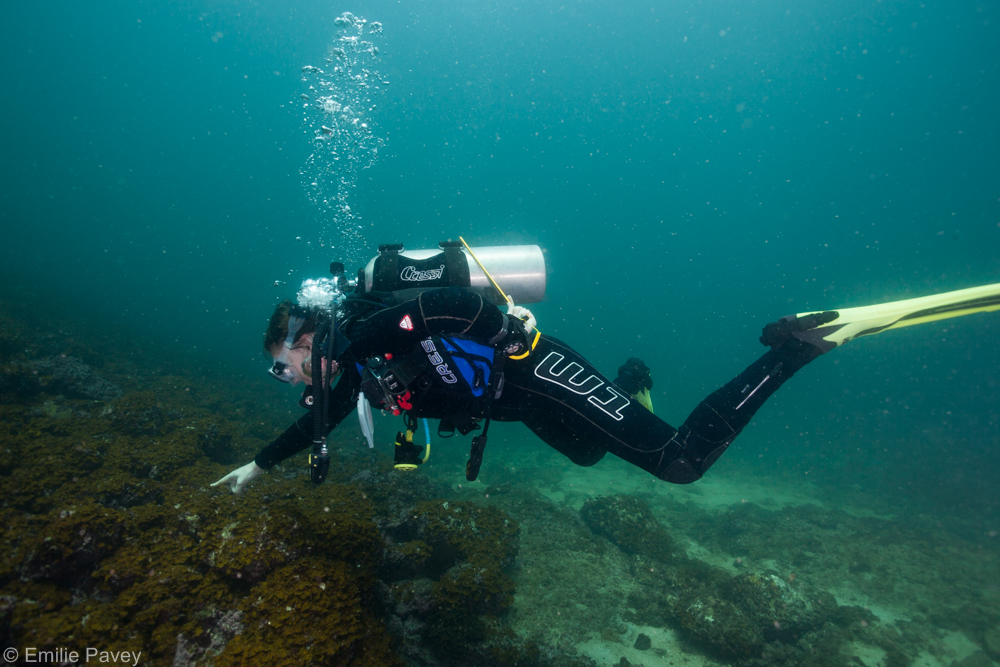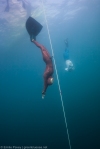The more you dive and the more you travel, the more you notice little things about other divers that drive you mad. For me, one of these things is the metal sticks (AKA pointers) that divers carry. They are so prevalent here in Hong Kong and yet so completely unnecessary.
Here are six reasons why sticks aren’t good. If you have a stick, I hope I can convince you to stick it in the bin!
1 — using a stick to compensate for poor control
Or — just as bad — getting into the habit of carrying a stick before you have mastered your buoyancy control.
 Moments before a faceful of sea urchin?
Moments before a faceful of sea urchin?
If you start relying on a stick to keep yourself off the bottom, to buffer your ‘landing’ as you descend or to push off or away from things, it becomes a bad habit, and prevents you from working on improving your buoyancy control and maneuverability in the water.
If you are descending onto a bottom (i.e. practically all dive sites in Hong Kong) control your descent and anticipate it. Add a bit of air into your BCD as you get close and use your lungs to ‘brake’. To lift off from something, inflate your lungs and rise up gently. And to get away from something, I’d really recommend learning how to back kick. I mastered it quite recently and I now find it unbelievably useful. It takes a bit of practice so if you are not there yet but you need to ‘reverse’ away from something, and rising up is not possible, use a careful one finger push as a last resort (in warm water, no gloves — they make you careless too!). Using one finger will make you a lot more cautious about what you are potentially damaging.
2 — using a stick to poke stuff
 “Don’t you wave those foul tentacles at me, draw your sword and fight me like a man!”
“Don’t you wave those foul tentacles at me, draw your sword and fight me like a man!”
This is just a big no no, but there are two categories of this behaviour. The first arises when photographers (or divemasters assisting them) are a bit too keen to get a photo. Yes it’s irritating if that cool little critter receded into the shadow of its hole (probably for a good reason) or if there is something in the way of your otherwise perfect shot (in HK read: sea urchin). If you didn’t have a stick, you would (and should) move on to a subject that you can photograph easily without causing a disturbance, but having a stick makes it tempting to go in for a poke or a nudge. Just don’t! Martin Edge summarises a more ethical approach to getting a shot in his book The Underwater Photographer:
‘… many [photo opportunities] are simply unphotographable [due to] the subject’s location … If it looks problematic, then forget it … You will find the same species in another, photographer-friendly situation [and] you will be content in the knowledge that you have behaved with integrity … and done your bit for the environment of the reef.’
While this first category of ‘poking behaviour’ is bad, the diver’s motivations can be understood. The second category is just pure stupidity: poking around just because you can. Like the retired Japanese diver I once met in the Philippines who with his stick applied sandpaper-like friction to every single gorgonian we passed, in an attempt to find a pygmy seahorse. With that violence, I doubt even a normal-sized seashorse would have stood a chance. The craze for spotting certain macro critters is sadly to the detriment of their survival. Woe bedite the pygmy that lives on a big sea fan within recreational depth at a popular dive site! Bottom line: if you don’t carry a stick, you’re probably not going to want to poke things. So don’t.
3 — ‘needing’ a stick in case of a current
 “I’m hanging on for dear life in this vortex!”
“I’m hanging on for dear life in this vortex!”
Some parts of the world and some dive sites do have very strong currents. In Hong Kong, currents are usually mild or non-existent, so this point is not an excuse. Let’s assume however that we are at a divesite somewhere with a strong current. Normally if there is a chance of this, then it should have been planned for and you’d drift — not fight it by jabbing a stick into the reef.
If there is a need to go against the current for a while, as long as the current is moderate, it’s quite possible to make gentle progress by staying low against the bottom where the current will be less strong. If you need to pause or stop, try to shelter in the lee of a large object which blocks the flow of water and you can rest. Finally, if it’s a dive where there’s a current but you plan to stay in one place to watch marine life, such as the famous Blue Corner in Palau, a reef hook can be used, and this is provided or can be rented from the dive centres.
Don’t endanger yourself in a current, always plan your dives carefully, and ask about the chance of current if you’re at a new site and you’re not sure. Trust me, you won’t need a stick.
4 — using a stick as a monopod
 “Let me whip out my stick-o-pod for a quick snap!”
“Let me whip out my stick-o-pod for a quick snap!”
People who do this give underwater photographers a bad name! Admittedly, it is difficult to frame a macro subject carefully underwater if there’s swell or any sort of movement in the water. In strong swell, there’s pretty much no point in trying to take pictures — you’ll be bashed around, you’ll get terrible shots, you’ll get frustrated and you’ll damage the environment in the process. If this is the case, accept that it won’t be a photo dive and just enjoy the dive.
Photographers can really benefit from getting very comfortable with their buoyancy — I actually learned to fine-tune my buoyancy because I was taking so many photos early on in my diving. With calm conditions and a well-balanced, neutral camera set up, framing a shot while hovering is perfectly manageable and there’s no need to collapse on the bottom or lean on a stick. With digital photography, you can keep shooting until you’re satisfied your shot is as you want.
However, if there’s a little bit of water movement and you really must make contact with the reef to take a photo, a ‘stick-o-pod’ remains a poor option due to its fixed length — you may not be able to get the angle you need. While the rest of your body is hovering neutrally, you can carefully rest one elbow on the sand, or use that one-finger touch again on a non-sensitive spot of reef and do the same thing much more flexibly — and you’ll be more cautious about the environment too. Again, obviously, no gloves needed in warm water. They’ll make you more clumsy with your camera too.
5 — letting a stick trail
 “I’ll throw in a dangling octopus for free!”
“I’ll throw in a dangling octopus for free!”
Ugh! It’s not just sticks that divers let trail, as demonstrated in this picture, but sticks are one of the culprits! There are so many reasons why this is not good: It’s not streamlined, it complicates your gear, it’s an entanglement hazard, and it leaves a micro-trail of destruction over the reef when you get close. Oh yes and it looks stupid. You should have learned this from your very first scuba training. Simple solution, just don’t carry one. However, if you have a very good reason for carrying a stick (see below), identify a spot in your gear where you can stow it away neatly.
6 — using a stick to tap on your tank
 “OMG OMG OMG look I found some algae.”
“OMG OMG OMG look I found some algae.”
Arguably, the only very good reason for carrying a stick is if you are leading a dive and you anticipate the need to get other divers’ attention. Tank-tapping should be done sparingly and there must be good grounds for doing so, for example actual emergencies, marshalling wayward tourists, or a passing whale shark. Good grounds do not include spotting a lionfish or clownfish every five minutes. Please keep quiet and let everyone enjoy the serenity of the ocean without auditory interruptions!
Conclusion: if you are a stickophile, I hope this blog post will make you reconsider. Try leaving it at home on your next dive, you’ll see how you’re just fine without it — it’s one piece of dive gear you can really do without! Stick it away and you’ll be a better diver for it.
A final word: no sea creatures were harmed in the making of this blog post! Also, a big thank you to Leigh who demonstrated spectacular buoyancy control hovering motionless in various highly un-diverlike positions and risked life, limb and jellyfish sting for this posed photo series (OK, only one of those three risks is true). Oh, and neither Leigh or I ever carry a stick.
Please feel free to leave a comment below and share your thoughts — stick-related or not.
If you enjoyed this post, please do follow this site by ‘liking’ its facebook page to receive future updates, or subscribe by email (scroll down, bottom right). Thank you!



Very well said. Although I do carry a short stick myself. I take it for emergencies and usually keep it in the sleeve of my wetsuit. And sorry to say this… Photographers are actually giving photography a bad name. To me anyways. Too many photographers are causing so much harm and damage just for the sake of a nice photo. And a lot of them think they have priority over people who choose to see the world with their own eyes instead of the 3-inch LCD screen.
LikeLiked by 1 person
True, agree that photographers might at times be inconsiderate of other divers in their keen-ness to get a picture by ‘hogging’ a spot. Usually if theres a group I let the non photographers take a look and move on (say,at a frogfish) before taking shots. And I prefer to lag behind the group and take my time, though a DM might not always appreciate that. If possible I buddy up with another photographer and we don’t dive in large groups – photographers and non photographers are completely different divers. But anyone – camera or not – loses my respect if they start poking things!
LikeLike
Hmm, wonder if this is a new thing or a Hong Kong thing, never ran into people diving with “sticks”. Commercial divers often fabricated a stick out of a welding rod to use for pipe flange alignments, and there’s the ole Hawaiian sling for spearfishing, but those are the closest things that come to mind and they have very specific uses.
LikeLiked by 1 person
The aluminium pointers used by many divers here in Asia have NO specific use and yet seem to be an essential item for many! No idea how long it’s been a thing…
LikeLike
Seen plenty of HK diving videos with people using cooking chopsticks – mostly for prodding octopus etc.
LikeLiked by 1 person